"The size of the universe is no more depressing than the size of a cow." -David Deutsch
But it is bizarre, I'll give you that. The most common scientific question I get asked is how, if the Universe is 13.7 billion years old, and the speed limit of the Universe is the speed of light, why do I say the observable Universe is 93 billion light years across?
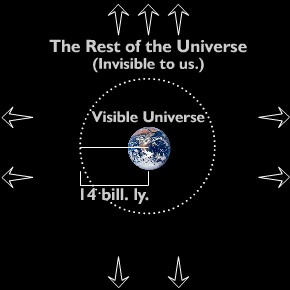
In other words, why is this picture of the Universe wrong?
I've tried to answer this before, and so have others, but perhaps it's time for another -- more conceptual -- attempt. This is one of the most mind-boggling things about relativity. From special relativity, you know that you can accelerate any mass to move faster and faster, up to but never quite reaching the speed of light.
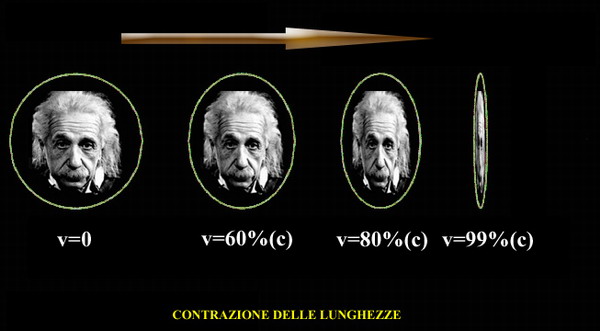
The closer you get to the speed of light, the more lengths get contracted and time gets dilated.
But in general relativity, you are limited by the speed of light relative to your own location in spacetime.
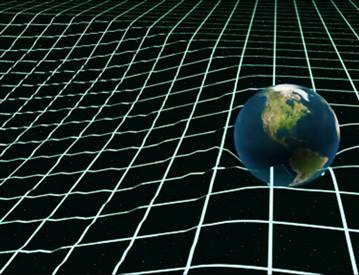
And although it's tempting to think of spacetime as a static grid, it isn't.
Because if the Big Bang and General Relativity are both correct, then spacetime is expanding.
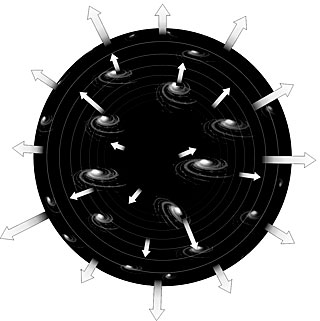
This might appear to you as galaxies moving away from us, and the farther away you look, the faster they appear to be moving, but that's not what's actually happening.
Rather than galaxies speeding away from us, like they would in an explosion, the galaxies themselves are stationary (which, for our purposes, means moving at less than 1,000 km/s), but the space between galaxies is expanding.

In other words, it's not like an explosion; expansion is very different. Wherever matter isn't densely clustered enough to us -- like beyond our local group of galaxies -- it appears to be moving away from us. And the farther away from us it is, the faster it appears to be moving away!

Believe it or not, when this phenomenon -- the apparent expansion -- was discovered by Hubble in 1929, Einstein's General Relativity had already predicted that this would happen! In fact, it was one of the first solutions to General Relativity ever discovered.

Just like the galaxies painted on to the surface of this balloon aren't moving but are getting farther apart, because the balloon is expanding, the real galaxies in the Universe are getting farther and farther away from one another (and, therefore, from us), but due to the expansion of spacetime.
So with this picture in mind, you then have to turn to General Relativity, and ask it what determines the expansion rate?
The answer is "the sum total of all your different energy sources" at any given time. Dark matter, normal matter, dark energy, photons, neutrinos, etc., it all matters. As you've just learned, dark energy is most important now, dark and normal matter were more important in the near past, and radiation (photons + neutrinos) were more important in the distant past.

It turns out that, perhaps counterintuitively, the scale of your Universe (i.e., the size of the observable Universe) is related to the speed of light multiplied by the age of the Universe, but isn't exactly equal to it.
In a Universe filled with 100% radiation, the size of the observable Universe is twice that number; our observable Universe would be 27.4 billion light years in radius if that were the case.
In a Universe filled with 100% matter, the size of the observable Universe would be three times that number; our observable Universe would be 41.1 billion light years in radius in this case. And this is close, but not quite right.
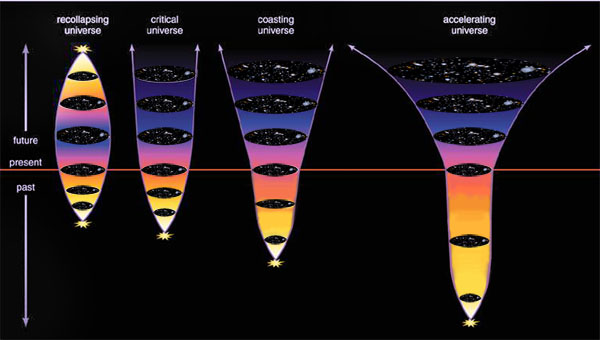
Adding a little bit of dark energy -- making the expansion accelerate in the recent past -- makes the observable Universe just a bit larger, and pushes the size of the observable Universe up to 46.6 billion light years in radius. Double that (to get a diameter), and that's why the Universe is 93 billion light years across!
But the stuff that's 46.6 billion light years away now was much closer in the past, and the total distance that light has traveled to reach us is 13.7 billion light years; it's just that the Universe has kept on expanding throughout that light's journey.

That's why the light gets redshifted; that's why the galaxies look like they're moving away from us. But what we're seeing is actually the expansion of the Universe, and the expansion continues before the light was emitted, during its travels to us, and after we've received it; and that's how the observable Universe can be 93 billion light years across, even though it's only 13.7 billion years old!



Great article. ("Only" 13.7 Billion? Some people are never satisfied...!)
Quick Q: If the great voids between galaxy superclusters were expanding individually, like bubbles, would that look obviously different from what we observe?
ÃniversiteöÄrencileri için hazırlanan iki önemli düzenlemenin ayrıntıları Åöyle:
20 BiN ÃÄRENCiYE PART TiME iÅ
Proje, Maliye BakanlıÄı veYÃK tarafından birlikte uygulanacak. Proje ile üniversitelerde de kitap giderleri devlet tarafından karÅılanmıŠolacak. Bu yardımlardan faydalanan öÄrencilerin, kredi ve bursları da kesilmeyecek.
Excellent post, Ethan (as always). A relatively straightforward explanation of a confusing idea.
Yes, this explanation is excellent.
Now whether I agree with that meaning of "apparent expansion" is a different issue.
Thank you for your very clear explanation. Now a related question.
Are OBSERVED voids truelly devoid of star matter? (e.g. 10^-10 or 10^-200 times as many stars as galaxies? Not what is theory; what is observational answer?
You did a nice job of explaining this. About 1/3 way, I thought I wouldn't get it and was about to ask "why is Andromeda on a collision course with the Milky Way within the context of an expanding universe (as analogized with an inflating balloon). I'm not exactly sure why local galaxies are exempted from this...
...but I stuck with the article and it actually started making sense, at least in terms of why light seems to indicate an older universe than we know.
Going back to the galaxies thing, is the speed of which Andromeda approaches the Milky Way affected at all by the expanding universe, dark energy, etc.? Or is that minimal due to the close proximity of the two galaxies?
How 'bout some love for Vesto Slipher, Georges Lemaitre, Milton Humason, et al for their integral role in Hubble's "discovery"? :)
Great post.
Also should be noted that although Einstein's GR predicted expansion, he didn't believe it and was a staunch defendant of a static universe for many years. He created a constant to counteract the prediction of expansion that he later redacted as the biggest "blunder" of his life.
The "expansionovertime.jpg" has three clips from this movie that I made several years ago for my astronomy class:
http://www.sonic.net/~rknop/php/astronomy/astromovies/cosmoz2.html
The thing to notice are that the distance between the galaxies when the expansion stars is less than the distance traveled by the photon, which in turn is less than the distance between the galaxies at the end. The one in the middle is the one that's the speed of light times the age of the Universe.
I really love this blog and have been learning a lot. Thanks for all of the work you put into it!
I'm trying to understand what this implies about the farthest galaxies in the Hubble Ultra Deep Field image. Wikipedia tells me that the farthest galaxy has a light travel time of 13 billion years. Would I be right to think that if we assume that our galaxy and those in the image are stationary, that it was a bit less than 13 billion light years away when the light was emitted, but now due to the expansion of the universe it is now somewhere around 46 billion light years away? Wikipedia mentions comoving distance of 30 billion light years - is that the same thing?
Thanks!
Rob Knop,
Thanks for uncovering the source of that image for me! I took three screenshots from a separate video I had found on youtube that used your footage, but I had no idea you were the originator of that!
I'll update the image credit to reflect your link; thanks for making that video!
Excellent effort by Ethan to explain a non-intuitive concept. Part of the confusion is that most of us are introduced to Hubble red shift by indirect analogy, ie. the Doppler effect from the sound of a train moving past us. Unf. this also introduces into our heads that Hubble red shift of distant galaxies is exactlyanalogous to a fast-moving train, which it is not for several reasons. First, the train analogy assumes that we are stationary and it is the train that is moving. Second, the train analogy assumes the train is moving relative to a fixed, static 'background' that is not changing. In a Hubble red shift, neither us or the train are moving (that much) but it is the 'static background' itself that is growing bigger, thus making it appear that either "we" or "the train" is moving within the background, depending on if we're on the train or standing next to the tracks. This analogy is still imperfect but I think is a bit better. Your light mileage may differ.
Hi.
We all agree that there is no absolute space and size. Is there a difference in the math whether spacetime is expanding or mass is likewise condensing? According to a principle of equivalence.
Cheers PL.
Mmm Hmmm... So, magic? Got it.
@Paul: The "comoving distance" of 30 billion light years is the "real" distance which that galaxy now has to us; the 46 billion light years is the "real" distance which the most distant things we can observe have to us (essentially the part of the hot plasma, with which the whole universe was filled back then, which was the source of the microwave background radiation we see now).
On the other hand, when the light of that galaxy was emitted, it had a distance of only about 4 billion light years to us (take the 30 billion light years and divide it by the redshift z of the galaxy, which probably is around 8 - could you provide a link to the relevant Wiki article?).
HTH
@Paul: Oops, sorry, small error: you have to divide by one plus the redshift, not only by z. If you mean this galaxy:
http://en.wikipedia.org/wiki/UDFy-38135539
that gives a distance at the time when the light was emitted of about 3.2 billion light years.
They are christian, Muslim or the other religions depending where they were born simply because they were indoctrinated by their parents as very young children. They will go on to indoctrinate their own children and those will go on to indoctrinate their grandchildren!!
Why does space-time expand?
@Tbird49er: Due to gravity, space-time can't simply remain static, it either has to contract or to expand.
Bir bambu aÄacı nasıl yetiÅiyor biliyor musunuz ?â Baktım ki bir bambu aÄacı nelere kadirmiÅ, özünden alıp insanı nerelere götürmüÅ. Bu istek ve amaç içinde olan kiÅi topraÄa bambu aÄacı tohumu eker ve sularmıÅ. Ä°lk yıl hep topraÄa ve dolayısıyla tohuma su vermekle geçermiÅ. Ä°kinci yıl aynı iÅlem devam edermiÅ
Kapadokya FotoÄraf ve Sinema Amatörleri DerneÄi BaÅkanı Mustafa Karakaya, yaptıÄı açıklamada, film ekibinin kendilerinden figüran oyuncu talebinde bulunduÄunu söyledi. Karakaya, talep üzerine yaptıkları duyuru sonucu iki günde Türkiye, Tunus ve Almanyaâdan 60âı kadın 150 kiÅinin filmde figüran oyuncu olarak rol olmak için baÅvurduÄunu belirterek, yapılacak seçme sonucu 60 kiÅiye rol verileceÄini kaydetti
What?
Don't forget that the universe cannot be considered as a simple three-dimensional structure (instead, think twenty-six dimensions!). Unlike a balloon, it has no beginning and no end, but rather curves back in on itself (in the same way a circle goes on forever). Its size cannot be estimated based on a simple expansion formula!
I greatly thankful to Sir Ian Stine for his theory of relativity which have given answer of many confusing questions.
the 46 billion light years is the "real" distance which the most distant things we can observe have to us (essentially the part of the hot plasma, with which the whole universe was filled back then, which was the source of the microwave background radiation we see now).
Thanks Ethan, wonderful little article, jargon free!
I am confused by the relation of "expanding space" to "expanding spacetime". In the article, you state that "if the Big Bang and General Relativity are both correct, then spacetime is expanding".... then, "the galaxies themselves are stationary... but the space between the galaxies is expanding".... then, the real galaxies in the Universe are getting farther and farther away from one another... but due to the expansion of spacetime". It appears that "space" and "spacetime" are interchangeable here. But would there not be quite a difference between an expanding spacetime and an expanding space?
its awesome..
@david: space-time is a result of Einsteins unification theory in a fashion (anyone correct me if i'm wrong here). Meaning space and time are related concepts, our concepts/perceptions of the fourth dimension "time" are directly correlated with distance.
As light travels over a certain distance it takes X time, this is more than just coincidence. Gravity bends space in such a way that it bends light, taking longer to move through space, altering our perception on time.
As space expands, so to does the length of time needed for light to travel it. So they should have a direct relationship as opposed to an inverse one.
Ethan, I think you are pulling my leg. But I will ask again, with some more detail (it is a while since I dealt with these concepts so I may be rusty). I think it is also accurate to say that our concepts/perceptions of the three dimensions "space" are directly correlated with "time" as we perceive it by our sense experience of light waves (or photons) meeting our eyes, etc. Maybe our sense of time is due to our sense of the intervals between wave peaks. But the point in the question I asked is to find out whether in your universe there is a difference between "expanding space" and "expanding spacetime". Expanding space would be the space (megaparsecs, kilometers) of the "Hubble law": so a receding object recedes at x kilometers per second per megaparsec. Even in this context, it seems to me that "space" must be seen as a physical entity: it has the physical property of expansion. And I believe this is also true of "spacetime", which I have seen described as an integral part of "the spacetime-energy complex", so integral that if the energy field disappears, so too does the spacetime. However, in the "Hubble law" concept, "time" seems to be a kind of absolute: a second is a "universal" second. So in an expanding space a ray (or wave, or photon) of light would travel x "stretched" meters in one absolute, constant, unstretched second, and the meter would stretch at x meters per unstretched second. Does that sound right? But if you turn it around, you could say that an expanding space is like a contracting time: a ray of light would travel x unstretched meters in one contracted second. And the second would contract at x seconds per second. So in that scenario, space doesn't expand, but time contracts. I think the effect is the same: it takes more seconds for light to travel through an expanding space. Or does it? Does it take fewer seconds (since the seconds are contracted) or more seconds (since there are more contracted seconds in the same unstretched space)? Hmm.
Regardless, we are told that according to general relativity, energy - in this case, the universal energy field - "warps" the spacetime continuum, as you pointed out. So that in an accelerated frame, "rays of light are propagated curvilinearly". And in a strong gravitational field, "time" slows down (clock ticks more slowly in stronger field). Now, does "space" contract or expand in such a field? I remember someone making the case that the universe is not expanding, the matter in it is contracting. Apparently the equations will work that way, but I don't know. At any rate, there seem to be two possibilities: space can contract or expand while time remains constant (or vice versa), then you have "expanding (or contracting) space" - or "contracting (or expanding) time". But if "spacetime" is a single physical entity - a continuum - then space and time must somehow act together: expanding space contracts, time "dilates" - that seems to mean clocks run more slowly. Then "expanding spacetime" would indicate a scenario in which space expands while time - what happens to time? Does it stay the same, or does it dilate, or does it contract? And finally what makes it possible to assert that a receding object is a certain distance away, receding at a certain velocity, if every local spacetime continuum is warped by the presence of various energy fields, bending, stretching and mutilating the light from that object? And how does anyone know what time it is (vis a vis any other time)?
Sorry Issac, I thought you were Ethan! My apologies. Anyway this was quite fun.
They are christian, Muslim or the other religions depending where they were born simply because they were indoctrinated by their parents as very young children. They will go on to indoctrinate their own children and those will go on to indoctrinate their grandchildren!!
it is waste of time to know how big is universe . actully the space or dark or u can say all that empty space in Space is God.when u go towards him with meditation u come to know every thing how big is universe and how many earths planets universes.the answer is only the creater knows how many universe and how big is universe and we can only make stupid guess nothing else,i have all the answers if any question do not hesitate to mail me
This is a very good explanation of a very interesting theory, by all means! Thank you. So...
If the Universe is expanding, does that mean that the galaxies that we see, at some 13 billion plus light years away, are actually farther away than the 13 billion light years? If a time measurement is taken from this instant for calculation purposes, and the universe has been expanding at an exceedingly accelerated rate, then in the time that it took for the light to reach us, would the universe have expanded much more, so that the distance of the galaxies right now would be much farther away than first thought? What we see are now are what the galaxies were billions of years ago, as I can understand. Or does this take into account the expansion that has taken place up until now?
Ok, I just re-read it. It may be too difficult to get any precise age because the light travelling to us has been affected by other forces, like gravity, maybe radiation, or other phenomenon.
Universe was initiated from nothing and kick started from a dot (even smaller the size of photon) and grew giant over the time and explodes since it can't take the pressure inside it. Explotion of terribly huge single particle shatters into infinitesmall particle soup and the particle are varying sizes. By association & dissociation of these particles, all the matters formed. From the matter all the celestial objects developed. Ultimately Universe start floating in the space. Then how to return back to nothingness? By constant expansion the Universe will be diluted into space and every galaxy will loose its power, stars will die off and slowly Universe will disappear into space. Blackhole will support for weakening of galaxies, stars and matters in the space. Finally there will be no such Universe will exist. After that some other place in the space, new Universe will kick start from a single point and go through BigBang, expansion, and dissolution. This cycle will occur repetitively. These are properties & attributes of the infinite space. We are all part of the Consciousness of Universe & Space. Thanks for reading my comments.
For one such cycle, it will take Trillion of Trillion of Trillion years. We are somewhere in the first quarter of this big time scale. Space is a natural sleeping consciousness and it awakens time to time in different domains of the space and evolve as Universe and slowly dissolve into space to return to its original state. Every single particle to all the Biological forms are evolution of Consciousness. Development of mind in the Biological system is leap of Consciousness from one fold to another. It is the journey of Space Consciousness in realizing "Who am I".
Why Space keeps on evolving as Universe repeatedly? If you take the Kaleidascope for example which contaisn few crystals of different size and color, everytime you rotate it, you will see different design and it is very amazing. Similarly Consciousness evolves as Universe in different domain space in different time, it goes through different experience. Everytime it evolves as Universe, its resultant experience is different from previous.
Fantastic
"The Universe is 93 billion light years across!"
Really? Are you sure it's not 93 trillion light years across, or 930 quintillion light years across, or perhaps even a googolplex or more in size? What lies beyond that vast realm? An impenetrable wall? Dark matter? A black hole? Void? Whatever it might be, it is still omnipresent, occupying space and part of a boundless, immeasurable Universe.
You state... “if the Big Bang and General Relativity are both correct…” Since you acknowledge both are unproven theories, you can’t apply speculative principles to a calculation and expect the result to be anything more than what you started with. Neither can you apply finite logic to something infinite and incalculable, and expect the result to have any rationale.
Is the term "infinite" even in the scientific community's lexicon? I suspect it’s avoided because the concept of a never-ending, endless, and inestimable cosmos might lend credence for the basis of an all encompassing, all knowing, almighty and eternal Creator. And that prospect must scare the bejesus out of anyone with an antichrist doctrine and faith in junk science. ∞ Boo!
"“The Universe is 93 billion light years across!”
Really? Are you sure it’s not 93 trillion light years across"
OK, the bits of the universe we can see is 93 billion light years across. Since the bit we see is proven to exist, it's not a stretch to call that "the universe".
Unless you want to be petty.
"You state… “if the Big Bang and General Relativity are both correct…” Since you acknowledge both are unproven theories"
Uh, they are the best theories we have and haven't proven them false.
Science doesn't do proof, so you're asking for the impossible, yet do not demand of yourself the same level of rigour.
Odd that, innit?
"Is the term “infinite” even in the scientific community’s lexicon?"
Yes.
@ Nathan T. Fenwick
I thought your good book gave you all the answers.. so what are you doing here?
"is the term “infinite” even in the scientific community’s lexicon? I suspect it’s avoided because the concept of a never-ending, endless, and inestimable cosmos might lend credence for the basis of an all encompassing, all knowing, almighty and eternal Creator"
LOL. No, really, literally, LOL. I'm LLOLing.
You've never heard of the "Steady State" theory -- that the universe was infinite and unchanging with neither beginning nor end in space or time? Yeah, it was quite a popular theory. Einstein's "greatest blunder" was all about trying to maintain it in the framework of his theory of gravity.
In fact there were *detractors* of the Big Bang theory that claimed it was religiously motivated since it sounds a lot (okay, a little bit) like the "Let there be light" creation story in Genesis. And the theory was in fact originally proposed by a priest -- albeit one who, like many such religious scholarly types, had a solid grounding in science.
But yeah, I'm sure this Catholic Priest only proposed this *obviously* stupid theory to avoid the implication that there might be a Creator! It's the collar, you see. It's just so dang uncomfortable, and if he could only disprove God then he could take it off.
LLOL. Thanks for demonstrating just how thoroughly ignorant you are, and how willing you are to fill in your void of ignorance with pure invention to arrive at your preconceived conclusion.
Hey, the universe was created by God. There was no such thing as the "Big Bang". God is our creator and God will end us all...... P.S. Lakers suck asss
No, Nick, YOU suck ass.
Because the only joy you get in life is trolling science you would never understand.
The entire universe has a diameter of 93 quintillion light years across. It is 46.5 times as big as the imaginary dodecahedron.